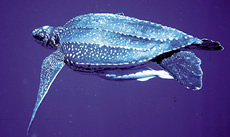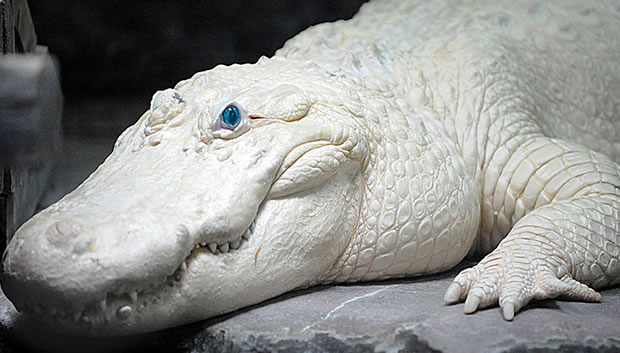

Leatherback Sea Turtle
Renato Rinaldi |
Creature Profile
The leatherback sea turtle is the largest of all sea turtles. The largest ever found was an 8.5-foot-long male weighing 2,020 pounds that washed up on the West Coast of Wales in 1988. This species is found throughout the Atlantic, Pacific and Indian oceans, from as far north as Labrador, Alaska, and Norway to as far south as Chile, the Cape of Good Hope, Argentina, and the southern end of New Zealand. The largest nesting population can be found in Mayumba of Gabon (Central Africa). Adult shell lengths range from 4.3 to 4.9 feet, and they generally weigh from 800 to 1000 lb. The shell is brown to black in color, and it is not bony like other turtles, but has seven raised ridges and a hard rubber texture. The front flippers are very long and powerful and can reach up to eight feet when extended, enabling this turtle to travel in the open ocean. The neck is short, and the head and neck are dark brown to black with white to yellow blotches.
This species prefers to remain in tropical, temperate, and subpolar seas, and it is known to migrate long distances to and from nesting sites. These nesting sites are usually along tropical beaches. This species prefers to eat jellyfish, but can also eat squid, fish, blue-green algae, and crustaceans. Nesting occurs between April and July at most North Atlantic sites and between November and January in the East Pacific. After mating offshore, females emerge from the sea at night and cross the beach to dig a nest about 39 inches deep in the sand. Each female can lay up to 85 eggs. They then cover the eggs with sand and return to the ocean. The eggs hatch 56 to 65 days later, and the hatchlings leave the nest by digging themselves out of the dirt and onto the beach surface. They then begin their trek to the ocean and spend most of their lives there.
Threats to this species include overexploitation and illegal hunting and capture of eggs (sea turtle eggs are a prized food for humans and animals), human disturbance for their preferred nesting sites, and water pollution. Some are often accidentally killed by fishing nets. Many programs have been established to prevent illegal trade and the stealing of eggs, and nature reserves have been established in the coastal areas where the turtles come to breed. In some areas, conservationists have taken the eggs into captive breeding programs to try to increase leatherback sea turtle populations.
Wikipedia Article

|
Wikipedia Article Copyright Notice: This article is licensed under the GNU Free Documentation License. It uses material from the Wikipedia article "Leatherback sea turtle". |
More Links about the Leatherback Sea Turtle:
Reference Links:Leatherback Sea Turtle - Wikipedia
Leatherback Sea Turtle - US Humane Society
Conservation Links:
Leatherback Trust
May 9, 2017
Glenn, C. R. 2006. "Earth's Endangered Creatures - Leatherback Sea Turtle Facts" (Online). Accessed 4/26/2024 at http://earthsendangered.com/profile.asp?sp=824&ID=10.
Need more Leatherback Sea Turtle facts?




